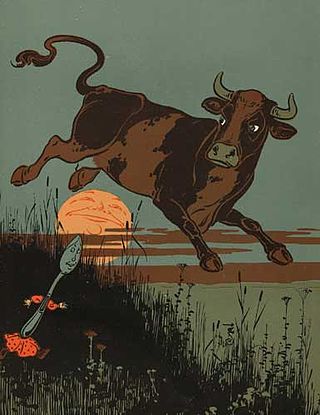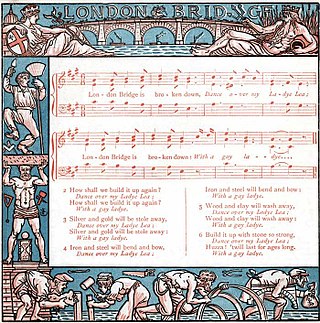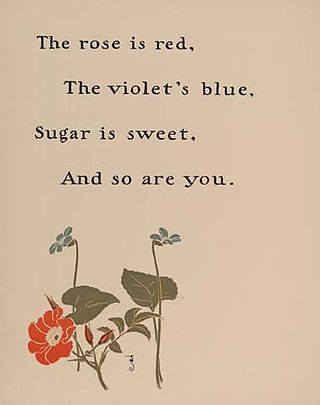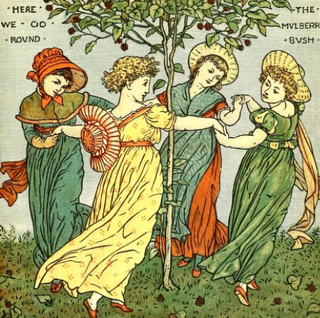| "Bobby Shafto's Gone to Sea" | |
|---|---|
 Sheet music | |
| Nursery rhyme | |
| Published | 1805 |
| Songwriter(s) | Unknown |
"Bobby Shafto's Gone to Sea" or "Bobby Shafto" (frequently spelled Shaftoe) (Roud 1359) is an English folk song and nursery rhyme.
| "Bobby Shafto's Gone to Sea" | |
|---|---|
 Sheet music | |
| Nursery rhyme | |
| Published | 1805 |
| Songwriter(s) | Unknown |
"Bobby Shafto's Gone to Sea" or "Bobby Shafto" (frequently spelled Shaftoe) (Roud 1359) is an English folk song and nursery rhyme.

The most common modern version is:
This is very close to the earliest printed version in 1805. A version published in John Bell's, Rhymes of Northern Bards (1812) gives these additional verses:
Other publications have made changes to some of the words, including the spelling of the last name:
The Opies have argued for an identification of the original Bobby Shafto with a resident of Hollybrook, County Wicklow, Ireland, who died in 1737. [1] However, the tune derives from the earlier "Brave Willie Forster", found in the Henry Atkinson manuscript from the 1690s, [3] and the William Dixon manuscript, from the 1730s, both from north-east England; besides these early versions, there are two variation sets for Northumbrian smallpipes, by John Peacock, from the beginning of the 19th century, and by Tom Clough, from the early 20th century. The song is also associated with the region, having been used by the supporters of Robert Shafto (sometimes spelt Shaftoe), who was an eighteenth-century British Member of Parliament (MP) for County Durham (c. 1730–97), and later the borough of Downton in Wiltshire. [1] Supporters used another verse in the 1761 election:
The song is said to relate the story of how he broke the heart of Bridget Belasyse of Brancepeth Castle, County Durham, where his brother Thomas was rector, when he married Anne Duncombe of Duncombe Park in Yorkshire. Bridget Belasyse is said to have died two weeks after hearing the news. [4]
Thomas & George Allan, in their illustrated edition of Tyneside Songs and Readings (1891), argued that the "Bobby Shafto" of the song was in fact his son, although his father fits the description of the lyrics better. [5] In reality, it is likely that his grandson, Robert Duncombe Shafto, also used the song for electioneering in 1861, with several of the later verses being added around this time. [6]

A nursery rhyme is a traditional poem or song for children in Britain and many other countries, but usage of the term dates only from the late 18th/early 19th century. The term Mother Goose rhymes is interchangeable with nursery rhymes.
"Twinkle, Twinkle, Little Star" is an English lullaby. The lyrics are from an early-19th-century English poem written by Jane Taylor, "The Star". The poem, which is in couplet form, was first published in 1806 in Rhymes for the Nursery, a collection of poems by Taylor and her sister Ann. It is now sung to the tune of the French melody "Ah! vous dirai-je, maman", which was first published in 1761 and later arranged by several composers, including Mozart with Twelve Variations on "Ah vous dirai-je, Maman". The English lyrics have five stanzas, although only the first is widely known. The song is in the public domain.

"Ladybird, Ladybird" is the first line of an English-language nursery rhyme that also has German analogues. It is included in the Roud Folk Song Index as number of 16215.

"Hey Diddle Diddle" is an English nursery rhyme. It has a Roud Folk Song Index number of 19478.

"London Bridge Is Falling Down" is a traditional English nursery rhyme and singing game, which is found in different versions all over the world. It deals with the dilapidation of London Bridge and attempts, realistic or fanciful, to repair it. It may date back to bridge-related rhymes and games of the Late Middle Ages, but the earliest records of the rhyme in English are from the 17th century. The lyrics were first printed in close to their modern form in the mid-18th century and became popular, particularly in Britain and the United States, during the 19th century.

"Ring a Ring o' Roses", "Ring a Ring o' Rosie", or "Ring Around the Rosie", is a nursery rhyme, folk song and playground singing game. Descriptions first emerge in the mid-19th century, but are reported as dating from decades before, and similar rhymes are known from across Europe, with various lyrics. It has a Roud Folk Song Index number of 7925.

"Roses Are Red" is the name of a love poem and children's rhyme with Roud Folk Song Index number 19798. It has become a cliché for Valentine's Day, and has spawned multiple humorous and parodic variants.

"Sing a Song of Sixpence" is an English nursery rhyme, perhaps originating in the 18th century. It is listed in the Roud Folk Song Index as number 13191. The sixpence in the rhyme is a British coin that was first minted in 1551.
A children's song may be a nursery rhyme set to music, a song that children invent and share among themselves or a modern creation intended for entertainment, use in the home or education. Although children's songs have been recorded and studied in some cultures more than others, they appear to be universal in human society.

"One, Two, Buckle My Shoe" is a popular English language nursery rhyme and counting-out rhyme of which there are early occurrences in the US and UK. It has a Roud Folk Song Index number of 11284.
"The Water Is Wide" is a folk song of Scottish origin. It remains popular in the 21st century. Cecil Sharp published the song in Folk Songs From Somerset (1906).

"There was an Old Woman Who Lived in a Shoe" is a popular English language nursery rhyme, with a Roud Folk Song Index number of 19132. Debates over its meaning and origin have largely centered on attempts to match the old woman with historical female figures who have had large families, although King George II (1683–1760) has also been proposed as the rhyme's subject.

Duncombe Park is the seat of the Duncombe family who previously held the title Earls of Feversham. The title became extinct on the death of the 3rd Earl in 1963, since when the family have continued to hold the title Baron Feversham. The park is situated one mile south-west of Helmsley, North Yorkshire, England and stands in 300 acres (120 ha) of parkland. The estate has a commanding location above deeply incised meanders of the River Rye within the North York Moors National Park.
Robert Shafto was a British politician who sat in the House of Commons between 1760 and 1790. He was the likely subject of a famous North East English folk song and nursery rhyme, "Bobby Shafto's Gone to Sea".
"Taffy was a Welshman" is an English language nursery rhyme which was popular between the eighteenth and twentieth centuries. It has a Roud Folk Song Index number of 19237.

"Here We Go Round the Mulberry Bush" is an English nursery rhyme and singing game. It has a Roud Folk Song Index number of 7882. It uses the tune which Nancy Dawson danced into fame in The Beggar's Opera in mid-1700s London. The same tune is also used for "Lazy Mary, Will You Get Up" and "Nuts in May". A variant is used for "The Wheels on the Bus".
"Girls and Boys Come Out to Play" or "Boys and Girls Come Out to Play" is a nursery rhyme that has existed since at least 1708. It has a Roud Folk Song Index number of 5452.
"Oh, Dear! What Can the Matter Be?", also known as "Johnny's So Long at the Fair" is a traditional nursery rhyme that can be traced back as far as the 1770s in England. There are several variations on its lyrics. It has Roud Number 1279.

"Ride a Cock Horse to Banbury Cross" is an English language nursery rhyme connected with the English town Banbury in Oxfordshire. It has a Roud Folk Song Index number of 21143.

'I Had a Little Nut Tree' is an English language nursery rhyme. It has a Roud Folk Song Index number of 3749.The song mentions a visit by the daughter of the King of Spain to request nutmeg and a pear. James Orchard Halliwell suggested that the song commemorates the 1506 visit of the Queen regnant Joanna of Castile to the English court of her brother-in-law, Henry VIII. However, the oldest known version of the song dates to 1797.